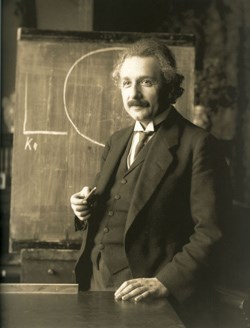Last updated: July 15, 2024
Article
New Jersey: Albert Einstein House

Courtesy of Ferdinand Schmutzer
Albert Einstein, considered the greatest physicist of all time and named in 1999 Time Magazine’s Person of the Century, was born to Jewish parents in Ulm, Germany in 1879. Although most famous for his theory of relativity (and specifically mass-energy equivalence, E=mc²), he was also known as an international advocate of peace, human rights and an early supporter of a homeland for the Jewish people. In 1880 his father, the owner of a small electrical appliance factory, moved the family to Munich, Germany. The Einsteins lived in Munich until 1894, when financial problems induced the family to move to Italy. A year later young Albert left home to attend the Federal Polytechnic School in Zurich, Switzerland. In 1896 he graduated from the school. Between 1900 and 1909 Einstein worked in the Zurich patent office. At the same time he worked on his Ph.D., which he received in 1905. It was also in 1905 that Einstein introduced the concept of “special relativity,” which is a theory of space-time, in his paper “On the Electrodynamics of Moving Bodies.” Special relativity broke from classical mechanics by the two postulates Einstein came up with; that (1) the laws of physics are the same for all observers in uniform motion relative to one another and (2) the speed of light in a vacuum is the same for all observers, regardless of their relative motion or of the motion of the source of light.
In 1909 he left the patent office to teach at the Federal Polytechnic School. A year later he accepted a call to teach physics at the German University in Prague. Einstein remained in Prague for two years and then returned to Zurich, this time as a full professor. By 1914 he had acquired an international reputation and was offered the position of director of Germany’s prestigious center of physical science research, the Kaiser Wilhelm Institute of the University of Berlin. Resuming his German citizenship Einstein spent the next 19 years living and working in Berlin. Although Einstein shunned publicity, his contradictions to physics made him a celebrated public figure constantly in demand at international conferences and meetings. Photographing a solar eclipse in May of 1919, British astronomer Arthur Eddington and his team claimed to have confirmed Einstein's prediction of gravitational deflection of starlight by the Sun. This event, followed by newspaper headlines exclaiming that Newtonian physics had been overthrown, threw Einstein further in the limelight. Later, it was proved that the instruments used by Eddington could not have accurately measured their claim, but later tests confirmed Einstein’s theory. It was also in 1919 that Albert Einstein wed Elsa Löwenthal. His first marriage, to mathematician Mileva Marić (1896), ended in divorce. The couple had three children.
In 1921, the Nobel Prize in Physics was awarded to Einstein, who began pursuing his dream of a unified field theory (an attempt to unify all the fundamental forces and the interactions between elementary particles into a single theoretical framework in physics). Post WWI politics in Germany were volatile, complicated by a severe German economic depression. When the German National Socialist Workers Party under Adolf Hitler came to power, with its anti-Semitic rhetoric and disregard for democratic principles, Einstein emigrated to the United States (which he had first visited in 1921) to accept a position at Princeton’s Institute for Advanced Studies. In the quiet New Jersey town, Einstein intended to lead a life of research and reflection, but once again his international fame required that he travel widely attending conferences and giving lectures. As the racial and totalitarian policies of Hitler’s Germany caused even more refugees to emigrate to the United States, Einstein became active in organizations that provided help. When World War II came, he lent his name and energies to the Allied cause. Einstein retired from the Institute for Advanced Studies in 1945 but continued to live and work in Princeton until his death on April 18, 1955. Albert Einstein was among the most famous scientists of the 20th century. Typical statements about him refer to a man who fundamentally changed the nature of 20th century science and he is given equal ranking with England’s Sir Issac Newton (1643-1727) in the history of physics.
The Albert Einstein House in Princeton, New Jersey, is a simple two-story, “L” shaped frame building with a gabled roof over the front block and a flat roof on the rear block. The exact date of construction and the builder of the Albert Einstein House are unknown, but the home was probably built in the 1870s or 80s. When Albert Einstein first came to Princeton in 1933, he lived at 2 Library Place. In 1936 he purchased 112 Mercer Street. The house remained his home until his death in 1955. 112 Mercer Street was an integral part of Einstein’s work in the United States. Ronald Clark, author of the biography Albert Einstein, wrote “…his room at the Institute (for Advanced Studies) or his study in Mercer Street was his natural habitat. It was here that he could best carry on his main work and continue his stubborn rearguard battle against the new movements in physics which he had started nearly a third of a century ago.” In April 1955 as Einstein lay in the hospital shortly before his death, he is reported to have asked his step-daughter Margot not to make his Princeton house a museum, a request she honored. The Albert Einstein House was designated a National Historic Landmark by the Secretary of Interior on January 7, 1976. Due to the wishes of Albert Einstein, the National Park Service did not publicize this at the time.
Though the home is a private residence, people are able to view the house from the street.
